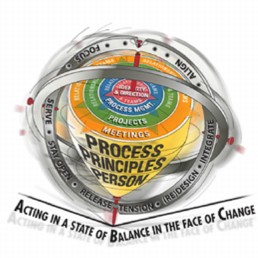An Interview with Sara Grigsby
Stories, conversations and cases
This is the third of four interviews with Sara Grigsby, the founder of Healthy
Systems and Senior OD Consultant for NW Natural Gas. Mira Ames, a communications
specialist who writes for Healthy Systems, conducts the interview.
The purpose of this interview is to provide a model of practice for leaders
– a model that supports healthy systems.
Click here for the interview
with Sara Grigsby.
We are interested in stories about organizational health, culture and operational
improvement. If you have a story to tell, please contact us at: info@healthysystems.net.
The ABCs of Change
Information and Insights

Healthy systems, both individuals and organizations, Act
from a state of Balance in the face of Change.
Leaders conduct meetings and act on long-range planning
within an ever-changing environment. Circumstances change
day to day. It takes balance to navigate these changing waters
and shifting tides.
Ultimately the locus of control to find balance and act from it lies within
each of us and within every member of your organization. Attitude plays a
part. Some people seem better at change than others. Discipline and practice
also play a part. How do individuals and organizations cultivate and maintain
this state?
In addition to the knowledge, skills and abilities (KSAs) in our specialties
and workplace expertise, a few core leadership practices help us to act from
a place of balance in the face of change.
Tips:
• PRACTICE #1: The discipline to hold a healthy
focus and a desired direction takes skill and discipline. Do you
know what you want and do you remind yourself of it every day. Strategic planning
and values clarification start you on this path but focus must be integrated
into daily work such as performance management systems and process design.
• PRACTICE #2: Cultivate KSAs for designing
your various activities to accomplish desired goals and strategies. For example,
can you design an effective meeting agenda? Do you know how to design a realistic
project plan?
• PRACTICE #3: A mindset of respect and experience
in serving the larger system within which you operate enables you
to move beyond limited perceptions and short sightedness. Humility, collaborative
relationships, consideration of others and gratitude balance pride, and competitive
and survivalist natures.
• PRACTICE #4: An openness to change
is based on a faith and experience that change can bring opportunity and potential.
New input and data signals the need for adaptation or resolve.
• PRACTICE #5: The KSAs needed to release
the bottlenecks and habits that restrict us are many and varied.
Operationally, you may have process bottlenecks that require process improvements.
Interpersonally you may experience impasses that require skills in negotiation.
Individually we all have blinders and face dilemmas that require new mindsets
and creativity.
Words and Meaning
Establishing a shared language
The following are definitions of key words found in the issue.
• Effort
A conscious exertion of power: hard work; A serious attempt, try; Something
produced by exertion or trying
•Conscious
Mindful; Purposeful; Aware
•Discipline
A subject or field of activity; A mental self control used
in directing or changing behavior, learning something or training for something;
The ability to behave in a controlled and calm way even in a difficult or
stressful situation; To make yourself act or work in a controlled or regular
way; A field of study; Training that corrects, molds or perfects the mental
faculties or moral character; Control gained by enforcing obedience or order;
Orderly or prescribed conduct or pattern of behavior; Self-control
•Commitment
An agreement or pledge to do something in the future; Devotion
or dedication, for example, to a cause, person or relationship;
-
subscribe to
The Yoga of Leadership!
-
• Continue to expand your skillset for managing organizational
change. Sign up to receive The Yoga of Leadership in your
email box. You'll receive each new issue, full of tips, reminders
and conversations on topics related to organization and professional development.
To subscribe now, email us at: subscribe@healthysystems.net
• Would you like to submit a tip or share something
you've have learned about organizational improvement? Got a war story? Have
a question or challenge you'd like help with? Do you have an improvement idea?
Email us at: info@healthysystems.net
• Would you like to be taken off our e-list? Email us at:
unsubscribe@healthysystems.net
• The Yoga of Leadership is published by
Healthy Systems,
PO Box 146, Corbett, Oregon 97019






